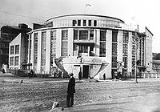
Kauchuk Factory Club
Encyclopedia
Kauchuk Factory Club is a 1927-1929 constructivist
public building designed by Konstantin Melnikov
, located in Khamovniki District of Moscow
, Russia
on the edge of Devichye Pole
park and medical campus at 64, Plyshikha Street.
, and was considerably expanded afterwards. Construction of a club was part of a 1920s nation-wide drive to replace religion with more appropriate entertainment. Melnikov theorized that "Club is not a stern temple of some deity. We must attain such an atmosphere, that we would not need to drag a worker in. He would run there himself, past his home and past his pub... the club, if it succeeds, will show what the new private life is all about" .
Kauchuk club is shaped as a simple quarter of cylinder, housing a 800-seat theatre hall with two balcony levels. Today, its shape and size is concealed by poplar trees and a Chinese restaurant terrace attached to the facade.
Melnikov's trademark exterior stairs were never intended for regular use; they are actually fire escapes connected to the second floor lobby.
 The club, like all 1920s buildings, is under threat of demolition. In 2003, despite the federal protective listing, the City of Moscow placed the building on a condemned property list. As of March, 2007, preservationists succeeded to delay demolition. The building operates a night club and a restaurant, and is in adequate external condition; huge neon lettering that existed in 2003, has been removed. However, its interiors are lost to indiscriminate renovation, original windows are replaced with impoperly-sized modern frames. According to Russian press, the building is operated by "Academy of Russian Art", established by pianist Nikolai Petrov
The club, like all 1920s buildings, is under threat of demolition. In 2003, despite the federal protective listing, the City of Moscow placed the building on a condemned property list. As of March, 2007, preservationists succeeded to delay demolition. The building operates a night club and a restaurant, and is in adequate external condition; huge neon lettering that existed in 2003, has been removed. However, its interiors are lost to indiscriminate renovation, original windows are replaced with impoperly-sized modern frames. According to Russian press, the building is operated by "Academy of Russian Art", established by pianist Nikolai Petrov
; it is not clear who actually owns the building, the Academy or the city of Moscow (the land, most likely, is a city property).
Constructivist architecture
Constructivist architecture was a form of modern architecture that flourished in the Soviet Union in the 1920s and early 1930s. It combined advanced technology and engineering with an avowedly Communist social purpose. Although it was divided into several competing factions, the movement produced...
public building designed by Konstantin Melnikov
Konstantin Melnikov
Konstantin Stepanovich Melnikov was a Russian architect and painter. His architectural work, compressed into a single decade , placed Melnikov on the front end of 1920s avant-garde architecture...
, located in Khamovniki District of Moscow
Moscow
Moscow is the capital, the most populous city, and the most populous federal subject of Russia. The city is a major political, economic, cultural, scientific, religious, financial, educational, and transportation centre of Russia and the continent...
, Russia
Russia
Russia or , officially known as both Russia and the Russian Federation , is a country in northern Eurasia. It is a federal semi-presidential republic, comprising 83 federal subjects...
on the edge of Devichye Pole
Devichye Pole
Devichye Pole is a historical medical campus, built in 1887-1897 in Khamovniki District of Moscow, Russia, to the master plan of Konstantin Bykovski. It is located between the Garden Ring and Novodevichy Convent...
park and medical campus at 64, Plyshikha Street.
History and architecture
Kauchuk rubber factory, originally based in Riga, relocated to Khamovniki in Moscow in 1915, threatened by German offensiveGorlice-Tarnów Offensive
The Gorlice–Tarnów Offensive during World War I started as a minor German offensive to relieve Russian pressure on the Austro-Hungarians to their south on the Eastern Front, but resulted in the total collapse of the Russian lines and their retreat far into Russia...
, and was considerably expanded afterwards. Construction of a club was part of a 1920s nation-wide drive to replace religion with more appropriate entertainment. Melnikov theorized that "Club is not a stern temple of some deity. We must attain such an atmosphere, that we would not need to drag a worker in. He would run there himself, past his home and past his pub... the club, if it succeeds, will show what the new private life is all about" .
Kauchuk club is shaped as a simple quarter of cylinder, housing a 800-seat theatre hall with two balcony levels. Today, its shape and size is concealed by poplar trees and a Chinese restaurant terrace attached to the facade.
Melnikov's trademark exterior stairs were never intended for regular use; they are actually fire escapes connected to the second floor lobby.
Preservation

Nikolai Petrov
Nikolai Arnoldovich Petrov was a Russian pianist.Petrov was born in Moscow, the son of the cellist Arnold Ferkelman and the grandson of the operatic bass Vasily Rodionovich Petrov, and began learning the piano at the age of three...
; it is not clear who actually owns the building, the Academy or the city of Moscow (the land, most likely, is a city property).

